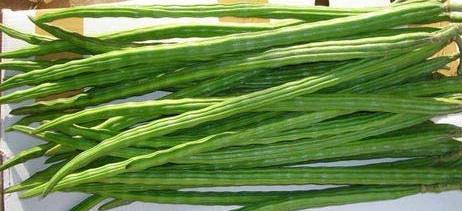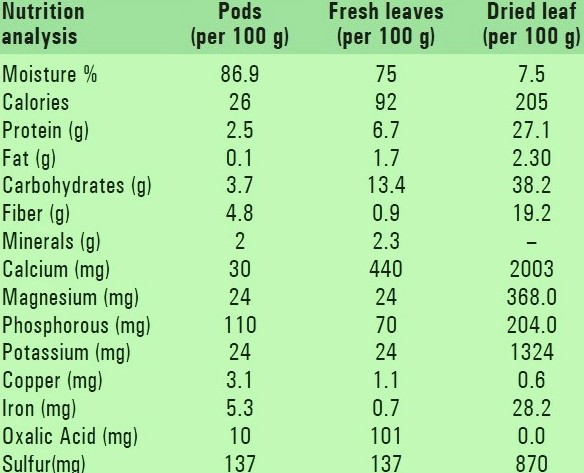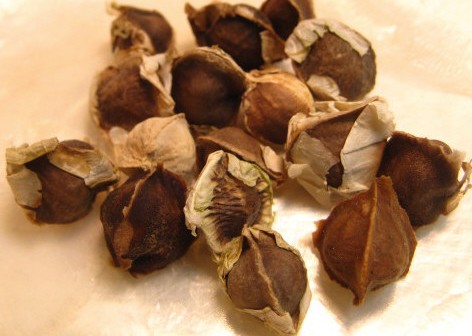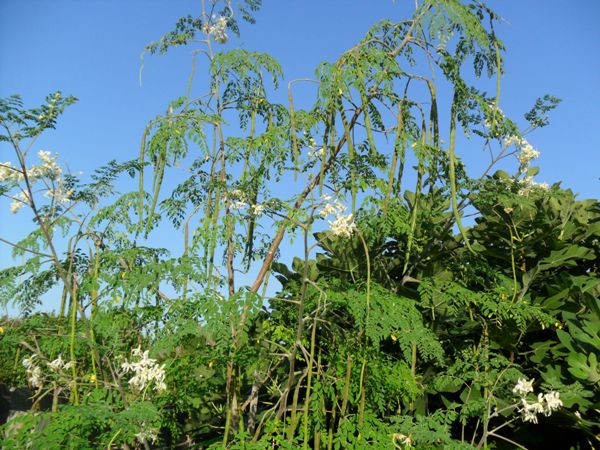Drumstick Cultivation Guide:
Introduction of Drumstick Cultivation:- Drumstick is a small or medium sized perennial tree which can reach up to 10 to 12 meter height with fragile and corky stem. The leaves are usually tri-pinnate with elliptic leaflets. Pods are pendulous and length ranges from 20 cm to 110 cm. Drumstick seeds are trigonous with wings on angles.
Usually, drumstick is grown for its nutrient rich tender, but full grown pods, leaves and flowers which are used in culinary (cooking) preparations. Young shoots have purplish or greenish-white, hairy bark. The drumstick tree has an open crown of drooping, fragile branches and the leaves build up feathery foliage of tripinnate leaves. These vegetables contain good amounts of vitamins and minerals. Drumstick has excellent health benefits along with other industrial uses. Drumstick can be grown in backyard or commercially in open fields. The moringa tree is called as “miracle tree” in Asia. Generally, moringa or drumstick can be cultivated for its leaves, pods, and/or its kernels for oil extraction and water purification.
Basically drumstick is originated from South West India and spread across many other Asian countries. Drumstick belongs to the family of “Moringaceae” and genus of “Moringa”. Drumstick also called as “moringa oleifera” or “horseradish tree” in many parts of the world. When farmers are planning for commercial cultivation of drumstick, it is better to go for soil testing. For obtaining high yield of drumstick, one can opt for local high yielding hybrid drumstick varieties.
Health Benefits of Drumstick:- Drumstick leaves and Drumstick pods are having great health benefits. Some of the health benefits and uses of drumstick/drumstick leaves are as follows:

- Drumstick improves nervous and immune system.
- Drumstick helps in fighting cold and flu and boosts immune system.
- Drumstick makes gallbladder healthy.
- Drumstick is very good for Diabetic patients.
- Drumstick helps in reducing cancer levels.
- Drumstick helps in reducing women period cramping.
- Drumstick is very helpful in asthma, bronchitis, tuberculosis patients.
- Drumstick improves digestion problems.
- Drumstick prevents urinary disorders.
- Drumstick helps Prevents from Impotency.
- Drumstick is very useful in increasing the bone density.
- Drumstick is good tonic for growing children.
- Drumstick is good for brain injury people.
- Drumstick is good for skin.
- Drumstick helps in High acidic Urine (Dysuria) patients.
- Drumstick is great for eye and retina health.
- Drumstick helps in reducing intestine tumor or ulcer.
- Drumstick prevents any lung problems.
- Drumstick is an excellent iron tonic and good for strong bones.
- Drumstick helps in preventing infections.

Major Drumstick Production Countries:- The drumstick crop is widely distributed in Singapore, India, Sri Lanka, Pakistan, Malaysia, Cuba, Egypt and Jamaica.
Varieties of Drumstick:- There are many local varieties of moringa available. However, there are some improved varieties are available.
PKM 1, PKM 2, Rohit-1, Coimbatore-1 and Dhanraj are famous improved cultivars in India and some local cultivars of moringa are as follows; Jaffna moringa, yazhpanam moringa, puna moringa, pal moringa, kodikal moringa and chavakacheri moringa. Out of all these, PKM1 and PKM2 are the best for commercial production of moringa/drumstick. It is very good idea of finding best suitable local commercial cultivar from nearest local horticulture/agriculture departments or universities.
Local Names of Drumstick in Asia:- Sajivan (Nepali), La mu (Chinese),ドラムスティック (Japanese), dùi trống (Vietnamese), Baget (Turkish), Trumstock (Swedish), මුරුංගා/Murunga (Sinhalese, Sri Lanka),Habbah ghaliah (Arabic)
Local Names of Drumstick in India:- Drumstick (English), Muringakkai (Tamil), Muringakkaya, Muringakka (Malayalam), Munnakaya, Mulaku Kada, Munaga (Telugu), Nuggekai (Kannada), Sajjan Ki Phalli, Saigan, Shinga, Segva, Sehijjan (Hindi), Sajane Dauta, Sajna Danta (Bengali), Saragvani Shing, Saragavo, Suragavo (Gujarati), Masingasaang, Moska Saang (Konkani), Shevaga, Sheng, Sheerenga (Marathi), Sajana Chhuin (Oriya), Sajana (Manipuri), Savonjna (Punjabi), Nurge (Tulu).
Agro-climatic Requirements for Drumstick Cultivation:- The drumstick/moringa crop is grown mainly in dry and arid climatic conditions. It can also be cultivated in semiarid, tropical, and subtropical regions of the world. As moringa is a sun loving plant, it does not tolerate any frost or freezing conditions. The ideal temperature of drumstick cultivation is between 25°C and 32°C. High temperatures will cause the drumstick tree to shed the flowers. Though this crop prefers minimum rainfall and dry weather, proper irrigation is required in case of leaf production. Intensive/Commercial cultivation with good irrigation and good Cultivation management practice will result in excellent yield.
Soil Requirements for Drumstick Cultivation:- Moringa/Drumstick can be grown on wide range of soils. However, the best yield can be obtained in well-drained sandy or loamy soil. Basically this tree prefers a neutral to slightly acidic soils with pH range 6.2 to 7.0. Make sure to provide well-drainage otherwise there would be a tendency of rotting.
Propagation and Seed Rate in Drumstick Cultivation:- Generally, an annual types of drumstick trees are propagated by seeds whereas propagation of perennial types of moringa/drumstick are done through limb cuttings of 100 cm length and 6 to 8 cm diameter.

Direct seeding in pits or raising seedlings in nursery polythene bags can be carried out at seeds rate at 600 to 650 grams per 1 hectare land. It is advised to transplant 1 month old seedlings in the field. It is recommended to raise some extra plants in polythene bags for purpose of gap filling. Time of sowing of seeds for annual seed drumstick or planting of limb cuttings varies from region to region depending on receipt of monsoon or irrigation availability or cultivar.
Land Preparation, Planting in Drumstick Cultivation:- Land should be ploughed couple of times till the fine tilth stage and make sure to clear any weeds from previous crops. Well decomposed Farm Yard manure (FYM) @ 20 tonnes per hectare in last ploughing. Pits size of 50 cm x 50 cm x 50 cm should be dug at a spacing of 6.0 meter x 6.0 meter for perennial types. In case of annual types 2.5 meter x 2.5 meter spacing should be maintained. Each pit should be applied 8 to 10 kg well-decomposed farm yard manure. Drumstick trees can also be grown in alleys, as natural fences and associated with other crops. The spacing between drumsticks in agro forestry cultivation is usually 2 meter to 4 meters.
Intercultural Operations, Irrigation, Manures and Fertilizers in Drumstick Cultivation:- To facilitate side branches, shoot should be nipped off when the seedlings are at 70 cm to 75 cm height. Apply 100 grams of Urea, 100 grams of Superphosphate and 50 grams MOP and irrigation should be carried out heavily. Top dress plants with 100 grams of Urea and again 3 months after first application. It is advised to provide light irrigation for early emergence of seedlings for annual type.

After harvest of main crop, annual types are cut back to 1 meter height from ground level for rationing. These rationed plants develop new shoots and start bearing 4 to 5 months after rationing. Likewise about 3 ratoon crops can be taken. At each and every ratoon crop, plants should be supplied with N, P and K nutrients as already mentioned along with 20 to 30 kg’s of farmyard manure and immediate irrigation should be carried out.
Pests and Diseases in Drumstick Cultivation:- Drumstick is resistant to most pests. In very water-logged conditions, Diplodia root rot can occur. In very wet conditions, seedlings can be planted in mounds so that excess water is drained off. Cattle, sheep, pigs and goats will eat drumstick seedlings, pods and leaves. Protect drumstick seedlings from livestock by installing a fence or by planting a living fence around the plantation. In Asia, various caterpillars are reported to cause defoliation unless controlled by spraying appropriate solution.
Harvesting In Drumstick Cultivation:- Generally, flowering in drumstick cultivation varies from place to place. This is greatly influenced by rain, temperature, humidity, wind and soil temperature and soil moisture. When harvesting pods for human consumption, should harvest when the pods are still young about 1 cm in diameter. Older pods develop a tough exterior, but the white seeds and flesh remain edible until the ripening process begins. When producing seed for planting or for oil extraction, allow the pods to dry and turn brown on the tree. In some instances, it may be necessary to prop up a branch that holds many pods to prevent it breaking off. Harvest the pods before they split open and seeds fall to the ground. Seeds can be stored in well-ventilated sacks in dry, shady places.
Yield in Drumstick Cultivation:- The yield of drumstick vary widely, depending on season, variety, fertilization, and irrigation regimen. Drumstick yields best under warm, dry conditions with some supplemental fertilizer and irrigation. The yield could be around 50 – 55 tonnes of pods per hectare (220 pods per tree per year). Harvesting can be done manually with knives, sickles, and stabs with hooks attached.
Marketing in Drumstick Cultivation:- Drumstick has very high demand and can transported to local markets very easily.
Bottom Line of Drumstick Cultivation:- There is a good chance of decent profits in Drumstick Cultivation with proper management.
For Sheep Farming or Goat Farming: Read here.
For Agriculture in India: Read here.

We required Moringa (sahzan) plant, please suggest
I want to do drumstick farming, please guide me.
For complete drumstic farming and project report, check this: Drumstick Farming Project Report.
i m interested in Export quality drumsticks farming in nagpur, Maharashtra